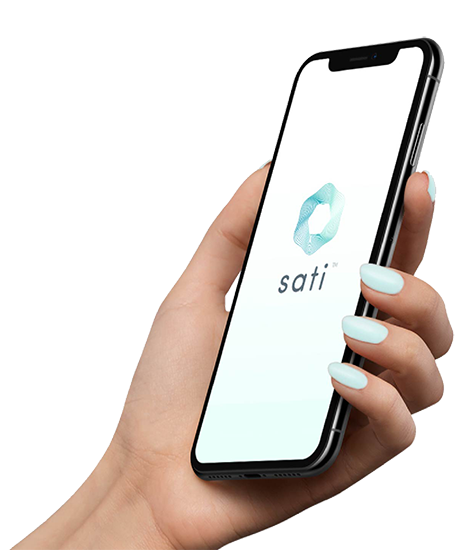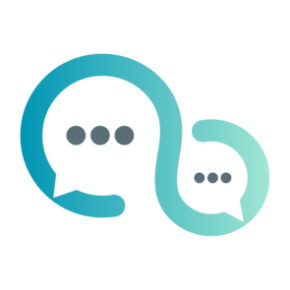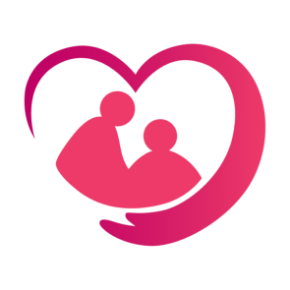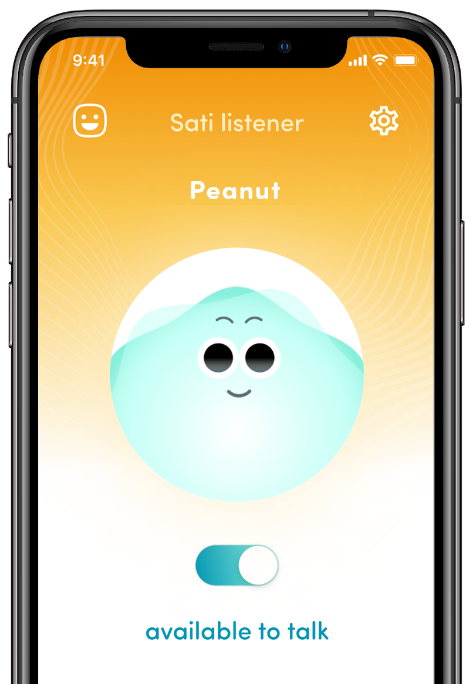что такое сати приложение
Sati — медитации и аффирмации 4+
Медитация под звуки природы
Microcosm Technology Inc.
Для iPhone
Снимки экрана (iPhone)
Описание
Начните погружение в медитации с Sati. Скачайте приложение и воспользуйтесь им для проработки всех аспектов личности с помощью медитации.
Sati не просто приложение, а углубленный курс медитации и осознанности, соединяющий древние знания и современную науку в простом, понятном и эстетичном интерфейсе.
Приложение включает два базовых раздела:
— пути (специально разработанный пошаговый курс);
— практики (для самостоятельной/дополнительной медитации).
В разделе пути вы будете каждый день получать новую медитативную сессию, которая состоит:
— из теоретической части: информация, которая поможет глубже понять медитации и сделать их привычкой;
— практической части: сама медитация от 7 до 20 минут, длительность практики постепенно повышается;
— интеграционной части: небольшие задания для наблюдения, которые помогут использовать в реальной жизни то, что получили во время практики, и плавно изменять к лучшему работу вашего ума.
После прохождения курса вы продолжите получать медитации и советы, которые помогут вам в дальнейшем пути к пробуждению.
В разделе практики вы можете:
— понять, в каком состоянии находитесь, и выбрать нужную практику очищения: лень, беспокойство, гнев, неуверенность, депрессия, страстные желания;
— потренироваться и выбрать любую из практик развития: удовлетворенность, концентрация, осознанность, мудрость, спокойствие, любящая доброта.
Особенности приложения:
— полноценный редактор звуковых атмосфер, где можно комбинировать и создавать свой уникальный звуковой фон: из мелодий, силы звука гонга, звуков природы, бинауральных волн и сублиминальных аффирмаций;
— раздел историй, где можно вести свои записи, дополнять их и слушать теорию или проходить сессию повторно;
— раздел профиля, где визуально отображается ваше развитие в медитациях в виде цветка жизни, который становится гармоничнее с каждой пройденной сессией;
— возможность включения расширенной практики медитации для самостоятельного контроля времени, отведенного на медитацию;
— можно включить интеграцию с Apple HealthKit, чтобы обмениваться информацией об осознанных минутах с другими приложениями.
Релакс музыка для осознанности
Microcosm Technology Inc.
Для iPhone
Снимки экрана (iPhone)
Описание
Begin your meditation journey with Sati. Download the app and use it to work through all aspects of your personality through meditation.
Sati is not just an application, but an advanced course in meditation and mindfulness, combining ancient knowledge and modern science in a simple, clear and aesthetic interface.
The app includes two basic sections:
— path (specially designed step-by-step course);
— practice (for independent / additional meditation).
In the path section, you will receive a new meditation session every day, which consists of:
— theoretical part: information that will help you better understand meditation and make it a habit;
— practical part: the meditation itself is from 7 to 20 minutes, the duration of the practice is gradually increasing;
— integration part: small tasks for observation, which will help to use in real life what you received during practice and smoothly change the work of your mind for the better.
After completing the course, you will continue to receive meditations and advice that will help you on your further path to awakening.
In the practice section, you can:
— to understand what state you are in and choose the necessary practice of cleansing: laziness, anxiety, anger, insecurity, depression, longing desires;
— practice and choose any of the development practices: contentment, concentration, awareness, wisdom, calmness, loving-kindness.
Features of the app:
— a full-fledged sound atmosphere editor, where you can combine and create your own unique soundscapes: from melodies, gong sound power, nature sounds, binaural waves and subliminal affirmations;
— a mindfulness diary where you can keep your notes, supplement them and listen to the theory or go through the session again;
— a section of the profile, where your development in meditations is visually displayed in the form of a flower of life, which becomes more harmonious with each session passed;
— the ability to include an extended practice of meditation for self-control of the time allotted for meditation;
— Integration with Apple HealthKit can be enabled to share lucid minutes with other apps.
Your safe space to share
Smart phone app which provides on-demand listening service to users
Available at

To understand someone going through mental issue is hard. It takes someone with high empathy to be able to help another person. Our mission is to create an army of empathetic listeners who are available 24 hours for you. An army of people who are ready to listen to you and be a shoulder for you to cry on. We believe that by talking, you will be able to uplift your mood and let go of anything that is holding you back.
Users

Listener Volunteers
Coming soon October 2021
Support the work that we do via Socialgiver. Every support provided will be used for providing listening services as well as for the continuous development of Sati App.
You can help others by
Look out for anyone who may need immediate help
Listen
Listen to someone from your heart and help create a safe space for them
Link the person to medical staffs once you have supported them as much as you can
Connect
Create a good connection with another person, give them space that they may need
Give them your time, do some activity together and let them know that you are here for them
Communicate
Be compassionate when talking to the other person and have a friendly body language
Stay in touch
Interested to be a user or a listener? Keep yourself up-to-date with our progress. Simply leave us your email address and we will keep you informed. We will make sure to be mindful with what we send you.
Sati stories
Sati hosts students from BU and UTCC
Sati got a chance to host students from BU and UTCC.
Our CEO selected to go to the Davos 2020
The Article from our CEO.
Sati Future
Sati AI
We are working on AI for GOOD program with Microsoft which once implemented will allow us to understand our users even more and for us to be able to cater better services to them.
Sati Forum
We are always seeking for answers, or a place where we can ask questions without being judged. That is why Sati is creating our very own “Mindful Forum” where users can ask any questions they have or reply to anyone who they feel connected with.
Sati Care
Mental Health doesn’t discriminate. We want to make sure that everyone has easy access to afordable Mental Health Care program with Sati.
Amornthep Sachamuneewongse
Founder/CEO
The engine of Sati App.
Ondřej
Nádvorník, MBA
Co-Founder/CTO
Ondřej is technological expert with more than 10 years of experience.
Chanon Wongsatayanont
Co-Founder/COO
The task master of Sati App
Nanta Taratarn
Psychological First Aid Project Coordinator
Pannarat Laovechprasit
Psychological First Aid Project Coordinator
Tomáš Martykán
Senior Maintenance Manager
Thipaporn Ananjaroenkul
Product Development Manager
Dr. Nattakorn Jampathong, M.D.
Advisor ASIA
Director, Khon Kaen Psychiatric Hospital
Dr. Varoth Chotpitayasunondh, M.D.
Advisor ASIA
Department of Mental Health, Thailand
Petr Winkler, Ph.D.
Advisor
National Institute of Mental Health, Czech Republic
Alexander
Kasal
Advisor EU
Researcher in National Institute of Mental Health, Czech Republic
Dr. Naeem Dalal, M.D.
Advisor
Mental Health Expert, Zambia
Dr. Helen Wigglesworth
Advisor
B.A., M.A. (Oxon), DClinPsy
Dmytro Turchyn, Ph.D.
Advisor AI
Artificial Intelligence Lead, CEE HQ at Microsoft
Thiparat Chotibut, Ph.D.
Advisor
Faculty of Science, Chulalongkorn University
Aliza Napartivaumnuay
Advisor
Co-Founder & Head of Partnerships at Socialgiver
Yeen Chalermvongsenee
Advisor
Tarin
Yuangtrakul
Visual Designer/Artist
Become a listener
We are always looking for individuals who are motivated to make our soceity a more empathetic one. Join us and become a part of our listener’s team at Sati. Learn more
Official Partners

Featured in

About
Listener
Tech Developer
Sati in Seoul, South Korea
We are pleased to be selected as the participant of the «2019 Startup Hub Korea» program organized by Seoul Global Startup Center, which provides opportunities for overseas startups to accelerate their startups and experience the Korean startup ecosystem. Sati was represented there by Ondřej Nádvorník, Co-founder of Sati on November 2019.
ABOUT THE SEOUL GLOBAL STARTUP CENTER
Founded in 2016 and funded by the Seoul Metropolitan Government, Seoul Global Startup Center (Seoul GSC) is an organization that supports foreign startups in the city of Seoul.
SGSC IS operated by a consortium of 2 private companies, WeWork Labs Korea & N15 hardware accelerator.
Since launch, They have successfully accelerated and supported a total of 85 unique startups to graduate our program in 3 different cohorts. Their most recent and current cohort has 44 participating startups.
Youth Mental Health conference
In April, Sati’s founder, Amornthep S. (Sanju), was nominated as one of the Global Shapers to attend the Youth Mental Health conference by World Economic Forum and Orygen in London,
United Kingdom. The conference invited delegates in the field of Mental Health from all over the world. Here is some of Amornthep’s personal experience:
“I was very excited to have been nominated to join the Youth Mental Health conference in London. It was a sort of invitation which was justifying that my voice as a Mental Health advocate is being heard. I certainly didn’t know what to expect at this 2 day conference and didn’t know if I would be able to share my idea to be heard by others.
When I was there, I was greeted by delegates from Orygen who was kind and were very happy to have me join the conference. That was the first positive sign for me. I slowly creep myself in to a circle of other delegates chatting about their work. There were Psychiatrist, Writers, Counsellors and representatives from various foundations across the globe who are well experienced of the problem with Mental Health. The thought started racing in me, whether or not I was out of my depth, whether I will be heard amongst these scholars or worst, whether I will have the guts to share my idea in front of them. I wanted to make sure that I shine as bright as them.
We were then separated in 7 different groups. At first I was afraid to give any input, when I started, it was amazing how they took in my comments and suggestions. How they positively reacted to what ideas I was bringing to the table. This is because I had something to share with them. The story of how I myself battled with Depression and Schizophrenia. I was able to show different aspects that they may not have thought of before. Moreover, thanks to Orygen, I was given the stage to share my difficult journey with Mental Health and my promise to make my community a more empathetic community and hoping spread the importance of empathy to the rest of the world.
Why Sati?
Our Founder, Amornthep S. (Sanju) is from Bangkok, Thailand and here is the story behind the name Sati.
“I personally went through Mental Health problems for 4 years now. The problem with Depression and Schizophrenia is that you constantly get anxiety and panic attacks. Whenever I have one of these attacks, I will always call a close friend who will remind me to breath and have “Sati”.
Being in a Buddhist majority country, you hear the use of the word “Sati” a lot which is the Buddhist term translated into English as “mindfulness”. To have “Sati” is to be conscious of your present and of your actions not just toward others, but also toward yourself.
The reason I have chosen this word as the name of our application is because it is important for us to be mindful of one another. Either if we are the one in trouble or if we know someone who needs help. By being mindful, we will be able to practise empathy which can lead to a kinder society.
However, when you are having anxiety attacks, panic attacks or just stressed, we can easily lose our “Sati” or our calmness. That is when we need to practise breathing or have a place where we can talk to someone safe to let out what is stressing us.
Sati is that place for you. A safe space for you to share your feelings. A place for you to gain back your conscious by sharing and caring.”
Sign up to our newsletter to be updated about our upcoming events and application.
The Diet for Healthy Mental Health
Can you eat your way to better mental health? Study says yes
It is well known that eating lots of fruit and vegetables is good for your physical health, but our latest research suggests that it might be good for your mental health too.
A study from Australia in 2016 found improvements in psychological well-being after increases in fruit and vegetable consumption. We wanted to know if this finding held true using a larger sample (more than 40,000 participants) from the UK Household Longitudinal Study.
Our analysis showed that increases in the consumption of fruit and vegetables are linked to increases in self-reported mental well-being and life satisfaction in data that spans a five-year period, even after accounting for other determinants of mental well-being such as physical health, income and consumption of other foods.
The benefits of physical activity for mental health are well established. The estimates from our work suggest that adding one portion to your diet per day could be as beneficial to mental well-being as going for a walk on an extra seven to eight days a month. One portion is equal to one cup of raw vegetables (the size of a fist), half a cup of cooked vegetables or chopped fruit, or one piece of whole fruit. This result is encouraging as it means that one possible way to improve your mental health could be something as simple as eating an extra piece of fruit every day or having a salad with a meal.
It is important to stress that our findings alone cannot reveal a causal link from fruit and vegetable consumption to increased psychological well-being. And we can’t rule out socalled «substitution effects». People can only eat so much in a day, so someone who eats more fruits and vegetables might just have less room in their diet for unhealthy foods. Although we accounted for bread and dairy in our study, ideally, future research should track all other foods consumed to rule out alternative explanations.
But when taken in combination with other studies in this area, the evidence is encouraging. For example, a randomised trial conducted in New Zealand found that various measures of mental well-being, such as motivation and vitality, improved in a treatment group where young adults were asked to eat two extra portions of fruit and vegetables a day for two weeks, although no changes were found for depressive symptoms, anxiety or mood.
Though our own study cannot rule out that people with higher levels of mental well-being might be eating more fruits and vegetables as a result, a recent commentaryon our work by the authors of the 2016 Australian study sheds further light on this. The authors show that the number of fruit and vegetable portions eaten in a day can predict whether someone is diagnosed with depression or anxiety two years later. But the reverse does not seem to be true. Being diagnosed with depression does not appear to be a strong predictor of fruit and vegetable consumption two years later. This suggests that it is perhaps more likely that eating fruits and vegetables is influencing mood and not the other way around.
Amornthep Sachamuneewongse
The engine of Sati App.
Living with depression and schizophrenia has not been easy.
When I first started complaining about my head to my family in 2015, they took me to the hospital, where a doctor recommended an MRI scan. The MRI came out clear, but my migraines persisted. It was suggested to my parents that I should see a psychiatrist. They said they had never thought about it. They didn’t know where to go, or who would be best.
We chose a well-known hospital in Bangkok, which had a small psychiatric department of just two rooms. I saw a doctor there for a few months, but I never got along with him. I felt that he didn’t understand me, and he told me to do things that didn’t feel like my “natural instinct”, if that makes sense.
As time went by, nobody understood what was going on with me, especially when I started hallucinating. My family thought that I was possessed and the best thing to do was to take me to see a ghost doctor. Not being a believer, that only made matter worse.
In December 2015, without telling my parents, I signed myself into a proper psychiatric hospital. I started seeing a doctor and a counsellor. They understood me more, and for the first time in eight months, I felt like I wasn’t alone. I finally told my parents that I was now visiting a psychiatric hospital.
By the time I saw a proper doctor, my condition had worsened. I was diagnosed with major chronic depression and schizophrenia, because I kept hallucinating. I started receiving diagnoses from December 2015, but by March 2016, my mental health had deteriorated badly. I was self-harming and talking about suicide during my hospital sessions. This prompted the doctor to prescribe me electroconvulsive therapy (ECT). There were only three hospitals in Bangkok, according to the information we had, that delivered ECT. All three were government hospitals.
My ECT treatment started in April 2016. I remember having to leave home at 6am to arrive and wait my turn, which usually came around 10am. I would wake up after my treatment at around 12.30pm, then go home. After receiving ECT 36 times, I was on the road to getting better. However, because of all the medicines I had been taking, I had gained 40kgs by then. This made it too dangerous to continue performing ECT on me. After two years of treatment, I have now gained 65kgs.
With everything that was going on with me, I decided to commit suicide in 2017. Saved by my parents, I was later admitted into the hospital for therapy again. Once I was out, I decided to leave Thailand for a couple of months to take care of myself.
As I was away from the environment I felt toxic to me, I was getting better. After 2.5 months when I came back to Thailand towards the end of 2017, I felt better. However that didn’t lasted long. I started going down the dark path again.
In June 2018, I decided to commit suicide again. However this time I tried calling the suicide hotline before doing on and my call wasn’t answered. In split seconds, I was back in the hospital again.
Once I came out, I was angry that no one answered my call when I needed them. So I tried calling the suicide hotline again and I took me 4 trials (over a period of 4 days) to get in touch with them. They told me the shortage of volunteers that they are facing when compared to the growing number of callers. As a back-up they gave me another number that I can called, which I tried right away and after 5 minutes, no one answered my call.
With all that I went through, understanding the importance of having someone to listen to you in time of need, understanding that being able to talk to someone can be a matter of life or death and understanding the overwhelming number of suicide cases, I decided to use start Sati App, an on-demand listening services.
Sati — медитации и аффирмации 4+
Медитация под звуки природы
Microcosm Technology Inc.
Для iPhone
Снимки экрана (iPhone)
Описание
Начните погружение в медитации с Sati. Скачайте приложение и воспользуйтесь им для проработки всех аспектов личности с помощью медитации.
Sati не просто приложение, а углубленный курс медитации и осознанности, соединяющий древние знания и современную науку в простом, понятном и эстетичном интерфейсе.
Приложение включает два базовых раздела:
— пути (специально разработанный пошаговый курс);
— практики (для самостоятельной/дополнительной медитации).
В разделе пути вы будете каждый день получать новую медитативную сессию, которая состоит:
— из теоретической части: информация, которая поможет глубже понять медитации и сделать их привычкой;
— практической части: сама медитация от 7 до 20 минут, длительность практики постепенно повышается;
— интеграционной части: небольшие задания для наблюдения, которые помогут использовать в реальной жизни то, что получили во время практики, и плавно изменять к лучшему работу вашего ума.
После прохождения курса вы продолжите получать медитации и советы, которые помогут вам в дальнейшем пути к пробуждению.
В разделе практики вы можете:
— понять, в каком состоянии находитесь, и выбрать нужную практику очищения: лень, беспокойство, гнев, неуверенность, депрессия, страстные желания;
— потренироваться и выбрать любую из практик развития: удовлетворенность, концентрация, осознанность, мудрость, спокойствие, любящая доброта.
Особенности приложения:
— полноценный редактор звуковых атмосфер, где можно комбинировать и создавать свой уникальный звуковой фон: из мелодий, силы звука гонга, звуков природы, бинауральных волн и сублиминальных аффирмаций;
— раздел историй, где можно вести свои записи, дополнять их и слушать теорию или проходить сессию повторно;
— раздел профиля, где визуально отображается ваше развитие в медитациях в виде цветка жизни, который становится гармоничнее с каждой пройденной сессией;
— возможность включения расширенной практики медитации для самостоятельного контроля времени, отведенного на медитацию;
— можно включить интеграцию с Apple HealthKit, чтобы обмениваться информацией об осознанных минутах с другими приложениями.










